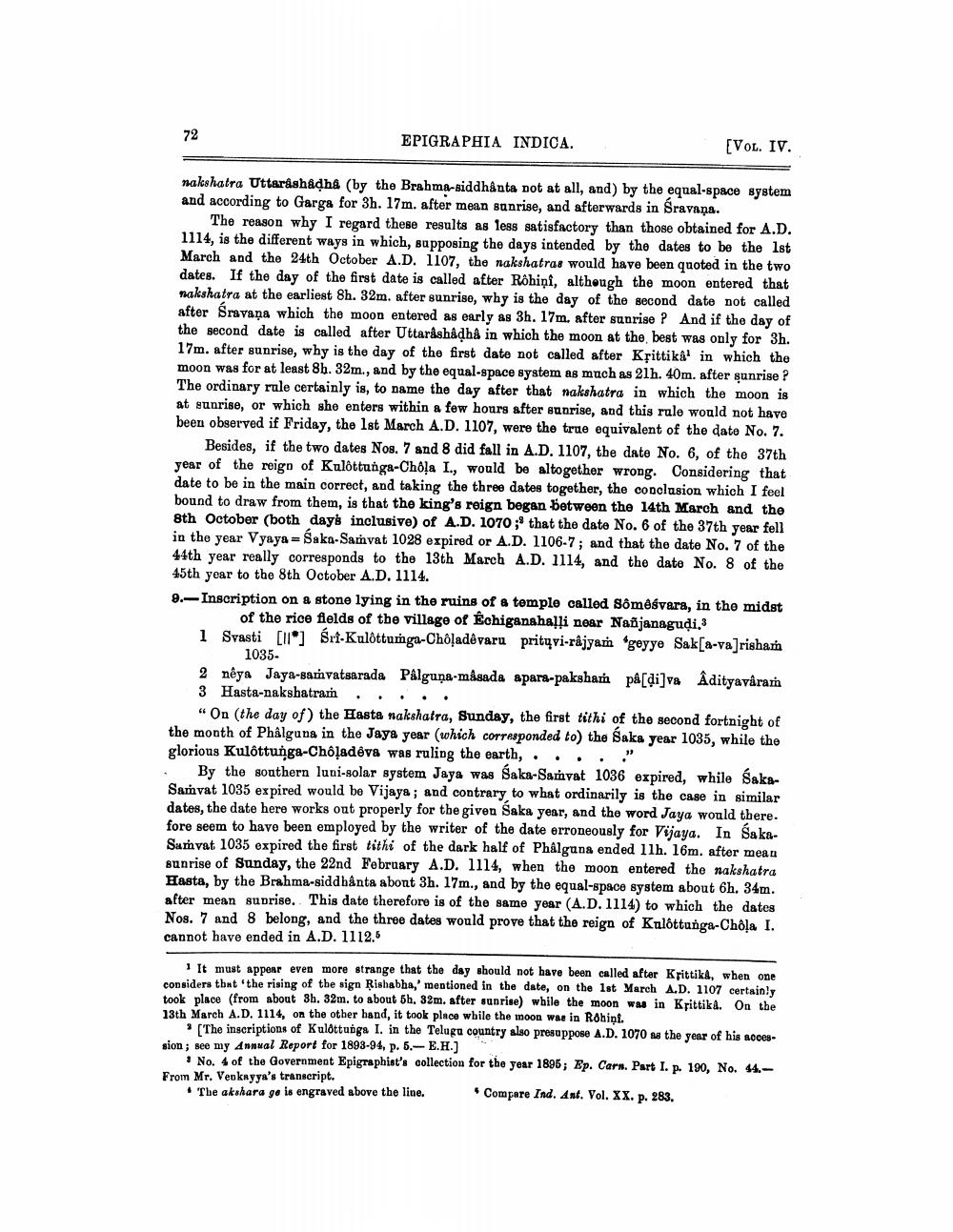________________
EPIGRAPHIA INDICA.
[VOL. IV.
nakshatra Uttarashadha (by the Brahma-siddhanta not at all, and) by the equal-space system and according to Garga for 3h. 17m. after mean sunrise, and afterwards in Sravaņa.
The reason why I regard these results as less satisfactory than those obtained for A.D. 1114, is the different ways in which, supposing the days intended by the dates to be the 1st March and the 24th October A.D. 1107, the nakshatras would have been quoted in the two dates. If the day of the first date is called after Rohini, although the moon entered that nakshatra at the earliest 8h. 32m. after sunrise, why is the day of the second date not called after Sravana which the moon entered as early as 3h. 17m. after sunrise ? And if the day of the second date is called after Uttaráshådhå in which the moon at the best was only for 3h. 17m. after sunrise, why is the day of the first date not called after Krittika' in which the moon was for at least 8h. 32m., and by the equal-space system as much as 21h. 40m. after sunrise ? The ordinary rule certainly is, to name the day after that nakshatra in which the moon is at sunrise, or which she enters within a few hours after suprise, and this role would not have been observed if Friday, the 1st March A.D. 1107, were the true equivalent of the date No. 7.
Besides, if the two dates Nog. 7 and 8 did fall in A.D. 1107, the date No. 6, of the 37th year of the reign of Kulôttunga-Chola I., would be altogether wrong. Considering that date to be in the main correct, and taking the three dates together, the conclusion which I feel bound to draw from them, is that the king's reign began between the 14th March and the 8th October (both days inclusive) of A.D. 1070;' that the date No. 6 of the 37th year fell in the year Vyaya = Saka-Samvat 1028 expired or A.D. 1106-7; and that the date No. 7 of the 44th year really corresponds to the 13th March A.D. 1114, and the date No. 8 of the 45th year to the 8th October A.D. 1114. 9.-Inscription on a stone lying in the ruins of a temple called Sômégvara, in the midst
of the rice flelds of the village of Echiganahalli near Naxjanagudi, 1 Svasti [ll*) Śr-Kulottumga-Chôļadêvaru pritąvi-rajyaṁ 'geyye Sak[a-va]risha”
1035. 2 nêya Jaya-samvatsarada Palguņa-mågada apara-pakshaṁ på[di]va Adityaváram 3 Hasta-nakshatram . . . . .
"On the day of the Hasta nakshatra, Sunday, the first tithi of the second fortnight of the month of Phålguna in the Jaya year (which corresponded to) the Saka year 1035, while the
glorious Kulôttunga-Chôļadeva was ruling the earth, ....." . By the southern luni-solar system Jaya was Saka-Samvat 1036 expired, while Śaka
Samvat 1035 expired would be Vijaya; and contrary to what ordinarily is the case in similar dates, the date here works out properly for the given Saka year, and the word Jaya would there. fore seem to have been employed by the writer of the date erroneously for Vijaya. In SakaSamvat 1035 expired the first tithi of the dark half of Phálgana ended Ilh. 16m. after mean sunrise of Sunday, the 22nd February A.D. 1114, when the moon entered the nakshatra Hasta, by the Brahma-siddhanta abont 3h. 17m., and by the equal-space system about 6h. 34m. after mean suprise. This date therefore is of the same year (A.D. 1114) to which the dates Nos. 7 and 8 belong, and the three dates would prove that the reign of Kulottunga-Chôļa I. cannot have ended in A.D. 1112.5
1 It must appear even more strange that the day should not have been called after Krittika, when one considers that the rising of the sign Rishabha,' mentioned in the date, on the 1st March A.D. 1107 certainly took place (from about 8h, 32m. to about 5h. 32m. after sunrise) while the moon was in Krittik. On the 13th March A.D. 1114, on the other hand, it took place while the moon was in Robini.
(The inscriptions of Kulottunga I. in the Teluga country also presuppose A.D. 1070 as the year of his accession; see my Annual Report for 1893-94, p. 5.-E.H.)
No. 4 of the Government Epigraphist's collection for the year 1896; Ep. Carn. Part I. p. 190, No. 14.From Mr. Veokeyya's transcript.
The akshara go is engraved above the line. Compare Ind. Ant. Vol. XX. p. 283.




